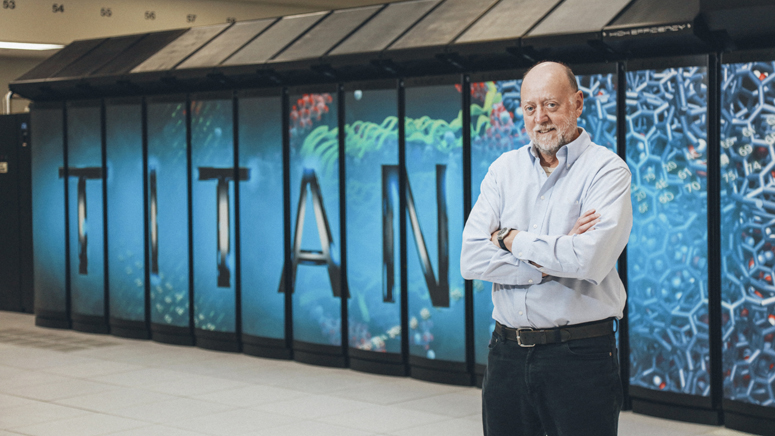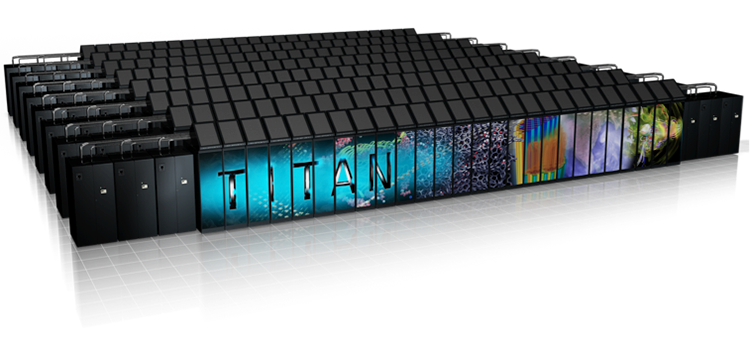The fastest computer in the United States fills a room the size of a basketball court and generates an electricity bill estimated at $9 million per year. Behind this titan-sized technology is the combined brainpower of a scientific team at the largest U.S. Department of Energy laboratory—Oak Ridge National Laboratory (ORNL)—which includes Jack Dongarra (M.S. CS ’73).

In his ORNL role, Dongarra helps develop methods for solving common problems that occur in scientific computing by designing algorithms and software that can solve numerical linear algebra problems for the next generation of supercomputers. In addition to his research position, he also serves as Distinguished Professor of Computer Science in the College of Engineering at the University of Tennessee.
“Today computational science has become a critical part of the modeling of many natural systems in physics, astrophysics, climatology, chemistry and biology, human systems in economics, psychology, social science, and engineering,” Dongarra says. “In order for it to be more realistic and accurate, we need larger computers that store a tremendous amount of data to help us better approximate the real world.”
Dongarra and his fellow researchers work with Titan, the second-fastest computer in the world. The most powerful computer is China’s Tianhe-2, built by the National University of Defense Technology.

“Normal laptop or desktop computers usually have a couple of processors,” says Dongarra. “Now think about programming something like Titan, with half a million processors.”
The performance of a computer is measured by the number of operations (addition or multiplication) that can be completed per second. Titan, the first supercomputer to utilize a hybrid CPU/GPU computing system, performs 17.6 x 1015 operations/second, measured in peta “flops” (floating-point operations per second). But those quadrillions of operations per second are nothing compared to the technology on the supercomputer horizon.
Dongarra says that by 2017–18 the hybrid CPU/GPU supercomputer Summit will be operational at ORNL and is expected to be 5 to 10 times as powerful as Titan. By 2023, he says, they anticipate computers operating at “exascale” (1,000 petaflops) with an exaflop goal of 1018 flops and parallelism around 1 billion. Dongarra explains that rather than using half a million threads of execution, problems will be solved using 1 billion threads of execution on the exascale computer system.
Dongarra says about half of the most powerful supercomputers are used in industries such as banking, and by companies that utilize the technology to design better products and services.
While this level of technology might not be at the forefront of people’s minds, the weather forecast usually is.
“Today supercomputers are used to simulate what the weather will be tomorrow,” he says, noting that computers operating at exascale will more efficiently and accurately estimate weather events such as hurricanes, increasing the potential for saving lives as well as reducing evacuation costs.
Supercomputers are not only forecasting the weather—they are also reaching for the stars. Dongarra was recently named to the Scientific and Engineering Advisory Committee for the international Square Kilometre Array radio telescope project. Information gathered from more than 130,000 antennas (an array) and 200 “dishes” at sites in Australia and South Africa, respectively, will be fed to exascale-level supercomputers that will analyze and process the data to help answer questions about the evolution of the universe and other cosmological topics.
Dongarra hadn’t yet envisioned extreme computing when he first discovered his love of computers. He was completing his bachelor’s degree in mathematics at Chicago State University with the intent to one day teach but says that “something happened that changed my life.”
During a final semester internship west of Chicago in the Applied Mathematics Research Group of Argonne National Laboratory, Dongarra realized how much he enjoyed working with computers. He then chose to pursue a master’s degree in computer science at Illinois Tech; the university offered him an assistantship that enabled him to work one day a week at Argonne. Following graduation in 1973, Dongarra was hired full time and earned his Ph.D. in applied mathematics from the University of New Mexico, while also conducting research at Los Alamos National Laboratory. By the time he left Argonne in 1989, Dongarra had risen in the ranks to senior scientist and is currently a member of the distinguished research staff at ORNL.
Dongarra, who received the Professional Achievement Award from Illinois Tech in 2013, is a member of the National Academy of Engineering and a fellow of several organizations including the American Association for the Advancement of Science, the Association for Computing Machinery, and IEEE. In his first year at the University of Tennessee he established the Innovative Computing Laboratory and has since served as its director. The laboratory has grown into an internationally recognized research facility and compiles the TOP500, a biannual list of the world’s 500 most powerful computer systems.
More Online
“Inside Titan”: www.ornl.gov/news/inside-titan-0